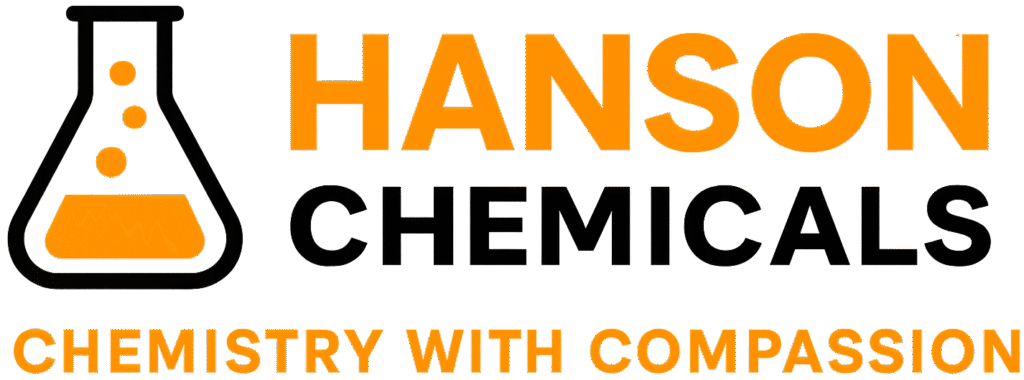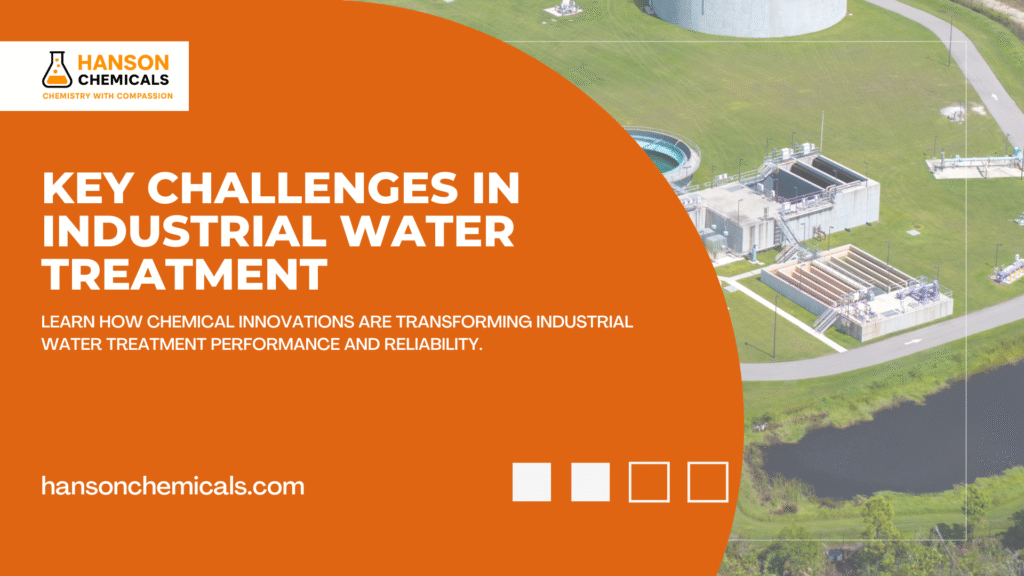Industrial water treatment is vital for maintaining operational efficiency, equipment longevity, and environmental compliance. Every manufacturing facility, from food processing and mining to pulp and paper, relies on clean, treated water to function smoothly. Yet, treating water at an industrial scale brings numerous challenges, such as scaling, corrosion, and biological contamination.
Chemicals play a critical role in solving these issues. Proper chemical treatment ensures water meets required purity levels, prevents costly damage, and supports sustainability goals.
In this article, we’ll examine the key challenges in industrial water treatment and explain how specific water treatment chemicals provide effective solutions to each.
Why Industrial Water Treatment Matters
Water treatment is not just about clean water—it’s about protecting systems, meeting regulatory standards, and reducing operational costs. According to the U.S. Environmental Protection Agency (EPA), untreated or poorly treated water can lead to severe compliance penalties and equipment failures, resulting in up to 40% higher maintenance costs.
Industries depend on treatment chemicals to:
-
Maintain water quality standards.
-
Protect equipment from scale and corrosion.
-
Control microbial growth.
-
Improve system efficiency.
-
Reduce environmental impact.
Major Challenges in Industrial Water Treatment
1. Scaling and Deposits
The Problem:
Scaling occurs when dissolved minerals like calcium and magnesium form solid deposits on equipment surfaces such as boilers, cooling towers, and pipelines. These deposits reduce heat transfer efficiency and restrict flow.
The Impact:
-
Reduced heat exchange efficiency.
-
Increased energy consumption.
-
Higher maintenance costs.
-
Shortened equipment lifespan.
Chemical Solution:
-
Scale inhibitors such as phosphonates (e.g., Hydroxyethylidene Diphosphonic Acid – HEDP)* prevent crystal growth and keep minerals dispersed.
-
Chelating agents like Citric Acid bind with metal ions to prevent scale formation.
Result: Improved energy efficiency and longer system life.
2. Corrosion in Equipment
The Problem:
Corrosion is the gradual destruction of metal components caused by chemical reactions with water and oxygen. It’s one of the costliest issues—industrial corrosion damages are estimated to exceed $2.5 trillion globally per year (NACE International).
The Impact:
-
Leakage or failure in heat exchangers and pipelines.
-
Increased downtime and repair costs.
-
Contamination of water with rust particles.
Chemical Solution:
-
Corrosion inhibitors such as phosphates and silicate-based compounds form protective films on metal surfaces.
-
Sodium Hydroxide is often used to control pH, reducing acidity that accelerates corrosion.
-
Zinc Chloride and amines also help by forming passivation layers on metals.
Result: Equipment integrity is maintained, and the system runs efficiently with reduced maintenance.
3. Biological Contamination
The Problem:
Microbial growth—bacteria, algae, and fungi—flourishes in untreated or stagnant water. This leads to biofilm formation, foul odors, and potential health hazards.
The Impact:
-
Clogged pipelines and filters.
-
Reduced cooling efficiency.
-
Microbially induced corrosion (MIC).
-
Health risks for workers.
Chemical Solution:
-
Biocides and disinfectants such as chlorine compounds, isothiazolinones, and oxidizing agents kill microorganisms and prevent biofilm buildup.
-
Sodium Hypochlorite and Sodium Chlorite are widely used for disinfection.
Result: Safer, cleaner systems with controlled microbial growth.
4. pH Imbalance
The Problem:
pH imbalance in process water can lead to corrosion, scaling, or reduced effectiveness of other treatment chemicals.
The Impact:
-
Acidic water causes corrosion.
-
Alkaline water encourages scale formation.
-
Poor chemical efficiency leads to higher treatment costs.
Chemical Solution:
-
Sodium Hydroxide and Potassium Hydroxide neutralize acidic water.
-
Sulfuric Acid and Phosphoric Acid adjust alkaline water levels.
Result: Balanced pH improves overall system performance and chemical efficiency.
5. Suspended Solids and Turbidity
The Problem:
Industrial water often contains suspended solids such as dust, organic matter, or fine particles that make it cloudy or turbid.
The Impact:
-
Reduced efficiency in filtration and heat transfer.
-
High sludge formation.
-
Poor water clarity.
Chemical Solution:
-
Coagulants and flocculants like Aluminum Sulfate (Alum) and Polyacrylamides help clump fine particles together for easy removal.
-
Sodium Polyphosphate enhances coagulation performance.
Result: Cleaner, clearer water with improved downstream treatment efficiency.
6. Heavy Metal Contamination
The Problem:
Industries such as mining, metal plating, and electronics release heavy metals like lead, chromium, and cadmium into wastewater.
The Impact:
-
Toxicity and environmental hazards.
-
Non-compliance with wastewater regulations.
-
Risk to human health and aquatic life.
Chemical Solution:
-
Precipitating agents and chelating agents bind with heavy metals to form insoluble compounds that can be easily filtered out.
-
Sodium Thiosulfate and Citric Acid are common agents for metal ion removal.
Result: Safe disposal of heavy metals and compliance with environmental regulations.
7. Foaming Issues
The Problem:
Foam forms when organic compounds or surfactants are present in water systems. It causes overflow, reduced efficiency, and sensor malfunctions.
Chemical Solution:
-
Defoamers and antifoaming agents such as Silicone-Based Compounds quickly break down foam and prevent recurrence.
-
These chemicals are essential in cooling towers, effluent plants, and wastewater recycling units.
8. Wastewater Reuse and Sustainability
The Problem:
With rising environmental concerns and stricter discharge norms, industries are under pressure to recycle and reuse water efficiently.
Chemical Solution:
-
Advanced treatment chemicals like organic polymers and oxidizing agents enable closed-loop water reuse.
-
Glycolic Acid and Formic Acid improve cleaning and regeneration of membrane systems.
Result: Enhanced sustainability, lower water consumption, and regulatory compliance.
Comparative Table: Key Challenges vs. Chemical Solutions
| Challenge | Chemical Solution | Example Products (Hanson Chemicals) | Key Benefit |
|---|---|---|---|
| Scaling | Scale inhibitors, chelating agents | HEDP, Citric Acid | Prevents deposits & improves efficiency |
| Corrosion | pH adjusters, inhibitors | Phosphates, Sodium Hydroxide, Zinc Chloride | Protects metal surfaces |
| Biological growth | Biocides, oxidizing agents | Sodium Hypochlorite, Chlorine dioxide | Prevents biofilm formation |
| pH imbalance | Acids & bases | Sulfuric Acid, Sodium Hydroxide | Maintains stable system chemistry |
| Turbidity | Coagulants, flocculants | Aluminum Sulfate, Polyacrylamides | Improves water clarity |
| Heavy metals | Chelating & precipitating agents | Citric Acid, Sodium Thiosulfate | Removes toxic metals |
| Foaming | Defoamers | Silicone-based compounds | Controls foam formation |
Best Practices for Industrial Water Treatment
-
Regular Monitoring – Track pH, turbidity, and conductivity to detect early issues.
-
Use Compatible Chemicals – Select chemicals that work well together to prevent reactions.
-
Optimize Dosage – Overdosing can harm equipment or reduce efficiency.
-
Partner with an Experienced Supplier – Reliable suppliers provide technical guidance, documentation, and consistent quality.
Learn more about Hanson Chemicals’ technical expertise and compliance assurance.
Regulatory Compliance in Water Treatment
Industries must meet strict wastewater discharge limits under the EPA’s National Pollutant Discharge Elimination System (NPDES). Failing to comply can result in fines and operational shutdowns.
Chemicals such as coagulants, neutralizers, and disinfectants are vital for ensuring treated water meets these standards before discharge or reuse.
For more details, visit the official EPA Industrial Wastewater Guidelines.
Future Trends: Toward Sustainable Water Treatment
-
Green Chemistry: The shift toward biodegradable, non-toxic treatment chemicals.
-
Smart Monitoring: Use of IoT sensors for real-time chemical dosing control.
-
Water Reuse Systems: Closed-loop recycling using advanced coagulants and antiscalants.
-
AI-based Optimization: Predictive maintenance to reduce downtime and chemical waste.
By aligning with sustainable practices, companies not only protect the environment but also cut costs and improve operational resilience.
FAQs
1. What are the most common problems in industrial water treatment?
Scaling, corrosion, biological growth, and pH imbalance are the most common challenges industries face in water treatment.
2. Why are chemicals important in water treatment?
Chemicals ensure water remains clean, balanced, and safe for industrial use. They prevent corrosion, scaling, microbial growth, and help meet environmental standards.
3. What types of chemicals are used in industrial water treatment?
Coagulants, biocides, antiscalants, pH adjusters, corrosion inhibitors, and defoamers are commonly used.
4. How do you choose the right water treatment chemical supplier?
Choose a supplier with strong technical support, regulatory documentation (SDS, TDS, COA), and reliable logistics—like Hanson Chemicals.
5. Are water treatment chemicals safe for the environment?
When used correctly, most industrial-grade chemicals are safe and compliant with environmental regulations. Eco-friendly alternatives are now increasingly used.
Conclusion
Effective industrial water treatment depends on understanding system challenges and selecting the right chemical solutions. From scale prevention to biological control, each treatment step ensures safe, efficient, and compliant operations.
As a trusted chemical manufacturer, supplier, and distributor with headquarters in Buffalo, NY and Burlington, ON, Hanson Chemicals delivers high-quality water treatment solutions supported by technical expertise, complete documentation, and dependable logistics.
With a strong warehouse and manufacturing network across Georgia, New Jersey, North Carolina, Texas, Ohio, and California, we proudly serve businesses across the U.S. and Canada, ensuring reliable supply, consistent quality, and long-term operational support for all industrial water treatment needs.
To discuss your requirements, visit Hanson Chemicals’ Water Treatment Division or Contact Us.

